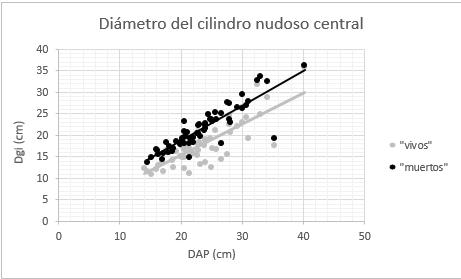Estimation of the stem diameter on the central knotty cylinder in oak basal logs, Chile
Main Article Content
Abstract
Downloads
Article Details
References
Besoain, E. Suelos volcánicos de Chile. INIA. 1985.
Björklund, L., Moberg, L. Modelling the inter-tree variation of knot properties for Pinus sylvestris in Sweden, 1999, (No. 207),
Ceballos, A.M. Combinación de Información Topográfica-Estructural LiDAR y Teledetección Hiperespectral para estimar la diversidad Florística Vascular de un Bosque Mediterráneo Caducifolio en la Precordillera Andina del Maule, Chile. Memoria de Título. Escuela de pregrado, Facultad de Ciencias Agronómicas, Universidad de Chile. 2015. pp 83
Corvalán, P. Diagrama de manejo de la densidad de rodal para el control del tamaño de ramas basales en bosques septentrionales altoandinos dominados por roble en la región del Maule. Santiago, Serie biomasa. Facultad de Ciencias Forestales y de la Conservación de la Naturaleza. Departamento Gestión Forestal y de su Medio Ambiente, Universidad de Chile, 2015, pp 120.
Corvalán, P. Caracterización del diámetro, ángulo de inserción y longevidad de ramas vivas axiales de Nothofagus obliqua. Revista Cubana de Ciencias Forestales, 2017, 5(2), 127-139.
Daniel, T., Helms, J., Baker, F. Principios de Silvicultura. Primera edición en español. De. Mcgraw-Hül. México. 1982
Grace, J.C., Pont, D., Shermann, L., Woo, G., Aitchison, D. Variability in stem wood properties due to branches. New Zealand Journal of Forestry Science, 2006, 36(2/3), 313.
Groot, A., Schneider, R. Predicting maximum branch diameter from crown dimensions, stand characteristics and tree species. The Forestry Chronicle, 2011, 87(4), 542-551.
Haig, I.T. Forest resources of Chile as a basis for industrial expansion. Forest Service, US Department of Agriculture. 1946.
Harris, R.W. Pruning fundamentals. Journal of Arboriculture, 1975.
Hein, S., Spiecker, H. Comparative analysis of occluded branch characteristics for Fraxinus excelsior and Acer pseudoplatanus with natural and artificial pruning. Canadian journal of forest research, 2007, 37(8), 1414-1426.
Karaszewski, Z., Bembenek, M., Mederski, P.S., Szczepanska-Alvarez, A., Byczkowski, R., Kozlowska, A., Giefing, D.F. Identifying beechround wood quality-distribution of beech timber qualities and influencing defects. Drewno. Prace Naukowe. Doniesienia. Komunikaty, 2013, 56(189).
Kozlowski, T.T, Pallardy, S.G. Growth control in woody plants. Elsevie.1997.
Lewis, N.B, Ferguson, I.S., Sutton, W.R.J., Donald, D.G.M., Lisboa, H.B. Management of Radiata Pine. Inkata Press Pty Ltd/Butterworth-Heinemann. 1993
Lowell, E.C, Maguire, D.A., Briggs, D.G., Turnblom, E.C., Jayawickrama, K.J., Bryce, J. Effects of silviculture and genetics on branch/knot attributes of coastal pacific northwest douglas-fir and implications for wood qualityA Synthesis. Forests, 2014, 5(7), 1717-1736.
Moberg, L. Models of internal knot properties for Picea abies. Forest ecology and management, 2001,147(2), 123-138.
Park. J.C. A grade index for pruned butt logs. NJFS, 1980, 10(2), 419-438.
Park, J.C. Peeled veneer yields from pruned Radiata Pine. En Proceedings of the conversion planning conference. FRI Bulletin N° 128,1987, Pp 201-218.
Petersson, H. Functions for predicting crown height of Pinus sylvestris and Picea abies in Sweden. Scand J. For. Res. 1997, 12(2): 179-188
Pinkard, E.A. Effects of pattern and severity of pruning on growth and branch development of pre-canopy closure Eucalyptus nitens. Forest Ecology and Management, 2002, 157(1), 217-230.
Sonderman, D.L. Stand density-A factor affecting stem quality of young hardwoods. 1985
Sutton, W.R.J., Crowe, J.B. Selective pruning of radiata pine. NZJ For. Sci, 1975, 5(2), 171-195.
Vestøl, G.I., Høibø, O.A. Internal distribution of sound and dead knots in Picea abies (L.) Karst. Holz als Roh-und Werkstoff, 2000, 58(1-2), 107-114.
Wang, C.S, Hein, S., Zhao, Z.G., Guo, J.J., Zeng, J. Branch occlusion and discoloration of Betula alnoides under artificial and natural pruning. Forest Ecology and Management, 2016, 375, 200-210


